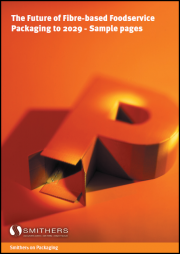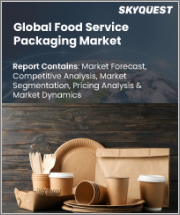
|
시장보고서
상품코드
1494939
세계의 섬유계 푸드서비스 포장 시장 전망(-2029년)The Future of Fibre-based Foodservice Packaging to 2029 |
||||||
주요 특징
- 2023년, 세계의 푸드서비스 시장에서 2조개 포장이 사용되어 금액은 추정 500억 달러였습니다.
- 이 시장에서 사용되는 섬유계 재료 금액은 2023년에 250억 달러로, 2029년까지 CAGR로 8%의 성장이 예측됩니다.
완만한 회복 후 푸드서비스 시장은 회복되며, 포장 소비도 그에 따라 성장하고 있습니다. 다양한 경질 플라스틱 포장의 성공적인 대안으로 떠오른 드라이 몰드, 드라이 폼 섬유 소재와 같은 새로운 포장 및 신기술의 도입으로 수요가 더욱 촉진되고 있습니다.
푸드서비스 산업은 식당, 커피숍, 바, 케이터링 업체 등 상업적 목적의 식품 및 음료 서비스를 제공하는 산업입니다. 이 산업의 제품은 조리기구에서 청소 용품, 포장에 이르기까지 다양합니다. 식품 포장은 식품 안전 및 위생 기준을 충족시키면서 보관 및 운송 중 식품을 보존하고 보호하는 중요한 역할을 담당하고 있으며, 업계는 환경 친화적이고 책임감 있게 폐기할 수 있는 지속가능한 제품으로 전환하고 있습니다.
세계의 섬유계 푸드서비스 포장 시장에 대해 조사분석했으며, 주요 촉진요인과 동향, 기술개발, 주요 제조업체등의 정보를 제공하고 있습니다.
목차
개요
- 개요
- 주요 촉진요인
- 기술의 진보
- 최종 용도와 지역
- 향후 전망
서론과 조사 방법
세계의 섬유계 푸드서비스 포장 시장
- 서론
- 시장의 개요
- 생산
- 주요 생산자
주요 촉진요인과 동향(2024-2029년)
- 거시경제의 영향
- 국내총생산(GDP)
- 도시화
- 인구
- 지정학적 긴장
- 환경면
- 재활용과 지속가능성
- 재사용 가능한 패키지
- 설계에 의한 순환성
- 새로운 패키지 디자인의 개발
- 마케팅 동향
- 배송 서비스
- 서브스크립션 서비스, 앱
- 소비자 의식
- PCR 재료의 사용
- 규제와 법률
- 경쟁하는 재료
기술개발(2024-2029년)
- 재료 동향
- 배리어 코팅의 개발
- 수성, 용제계, 고체 코팅, 라미네이션
- 해조 유래 재료 등 바이오폴리머 및 화석연료를 사용하지 않는 코팅의 진보
- 식품 및 액체에 직접 접촉하는 제품
- 재활용
- 향후 기술
- 성형 섬유
최종 용도 시장 규모와 예측(2019-2029년)
- 서론
- 최종 용도 시장과 용도
- 개요
- 식품 용기
- 음료 용기
- 포장판매
- Eat-in
지역적 시장(2019-2029년)
- 서론
- 세계의 순위
- 수량
- 금액
- 성장
- 1인당 수량
- 개요
- 아메리카
- 북미
- 미국
- 캐나다
- 멕시코
- 중남미
- 브라질
- 기타 중남미
- 북미
- 유럽, 중동 및 아프리카
- 서유럽
- 프랑스
- 독일
- 이탈리아
- 스페인
- 영국
- 기타 서유럽
- 동유럽
- 폴란드
- 러시아
- 기타 동유럽
- 중동
- 터키
- 기타 중동
- 아프리카
- 서유럽
- 아시아태평양
- 아시아
- 중국
- 인도
- 일본
- 기타 아시아 국가
- 호주
- 아시아
섬유계 푸드서비스 포장 산업의 상업적 진화
- International Paper
- Smurfit Kappa Group
- WestRock
- Stora Enso
- DS Smith
- Huhtamaki
- MM Packaging and Moulded Pulp
- Mondi
- Billerud
- Hartmann
- Pactiv Evergreen
- Dart
- Sabert
- OmniPac
- PulPac
- Yangi
Key Features:
- 2 trillion units of packaging were used in the foodservice market globally in 2023, worth an estimated $50 billion
- The value of the fibre-based materials used in this market is $25 billion in 2023, with a forecast growth rate to 2029 of 8% CAGR
After a slow recovery, there has been a rebound in the foodservice market and growth in packaging consumption has followed suit. Demand is further stimulated by the introduction of new packs and new technologies, such as dry moulded and dry formed fibre materials, which are proving to be successful substitutes for a variety of rigid plastic pack formats.
The foodservice industry provides food and beverage services for commercial purposes, including dining establishments, coffee shops, bars, and catering companies. Products in this industry range from cooking devices to cleaning supplies and packaging. Food packaging plays a crucial role in preserving and protecting food during storage and transportation while complying with food safety and hygiene standards, and the industry is moving towards sustainable products that are ecofriendly and can be disposed of responsibly.
Key questions:
- How packaging producers are meeting demand for a more sustainable alternative to plastics
- How the regulatory landscape will impact the market for foodservice packaging applications over the next five years
- What developments are being made in functional barrier coatings and how these are driving diversification in foodservice applications
- Who the key players are in the commercial evolution the fibre-based foodservice packaging industry.
This report benefits:
- Paper, pulp and paperboard producers
- Packaging converters and manufacturers
- Retailers and brand owners
Table of Contents
Executive summary
- Overview
- Key driving forces
- Environmental aspects
- Recycling & Sustainability
- Re-usable packaging
- Circularity by design
- New packaging design developments
- Marketing trends
- Geopolitical tensions
- Regulations and legislation
- Competing materials
- Environmental aspects
- Technology advances
- Material trends
- Developments in barrier coatings
- Water- and solvent-based, and solid coatings and laminations
- Advances in biopolymers and fossil-free coatings, such as seaweed-based materials
- Products for direct contact with foodstuffs and liquids
- Recycling
- Future technologies
- Moulded fibre
- Raw materials
- Coatings
- End uses and geographies
- Future prospects
Introduction and methodology
- Introduction
- Objectives
- Scope
- Methodology
- Definitions
The global fibre-based foodservice packaging market
- Introduction
- Market overview
- Production
- Major producers
Key drivers and trends, 2024-29
- Macro-economic influences
- Gross Domestic Product (GDP)
- Urbanisation
- Population
- Geopolitical tensions
- Environmental aspects
- Recycling and sustainability
- Reusable packaging
- Circularity by design
- New packaging design developments
- Marketing trends
- Delivery services
- Subscription services, apps
- Consumer awareness
- Use of PCR material
- Regulations and legislation
- Competing materials
Technology developments, 2024-29
- Material trends
- Developments in barrier coatings
- Water- and solvent-based, and solid coatings and laminations
- Advances in biopolymers and fossil-free coatings, such as seaweed-based materials
- Products for direct contact with foodstuffs and liquids
- Recycling
- Future technologies
- Moulded fibre
Market sizes and forecasts by end-use application, 2019-29
- Introduction
- End-use markets and applications
- Overview
- Food containers
- Drink containers
- Takeaway
- Eat-in
Geographic markets, 2019-29
- Introduction
- Global rankings
- Volume
- Value
- Growth
- Volume per capita
- Overview
- Americas
- North America
- United States
- Canada
- Mexico
- South & Central America
- Brazil
- Other South & Central American countries
- North America
- EMEA
- Western Europe
- France
- Germany
- Italy
- Spain
- United Kingdom
- Other Western European countries
- Eastern Europe
- Poland
- Russia
- Other Eastern European countries
- Middle East
- Turkiye
- Other Middle Eastern countries
- Africa
- Western Europe
- Asia-Pacific
- Asia
- China
- India
- Japan
- Other Asian countries
- Australasia
- Asia
Commercial evolution of the fibre-based foodservice packaging industry:
- International Paper
- Smurfit Kappa Group
- WestRock
- Stora Enso
- DS Smith
- Huhtamaki
- MM Packaging and Moulded Pulp
- Mondi
- Billerud
- Hartmann
- Pactiv Evergreen
- Dart
- Sabert
- OmniPac
- PulPac
- Yangi


















